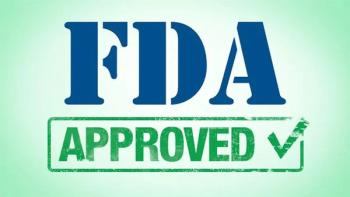
Olaratumab Now FDA Approved for Soft Tissue Sarcoma
Olaratumab (Lartruvo) has been granted an accelerated approval from the FDA for the treatment of patients with advanced soft tissue sarcoma.
Richard Pazdur, MD
Olaratumab (Lartruvo) has been granted an accelerated approval from the FDA to be used in combination with doxorubicin for the treatment of patients with advanced soft tissue sarcoma (STS) who are not candidates for radiotherapy or surgery.
The approval was based on data from the phase II JGDG trial, in which combining olaratumab with doxorubicin reduced the risk of death by 54% versus doxorubicin alone in patients with STS (HR, 0.46; 95% CI, 0.30-0.71; P = .0003). The median overall survival (OS) in the intent-to-treat population (n = 129) was improved by 11.8 months with the olaratumab combination versus doxorubicin alone.
"For these patients, Lartruvo, added to doxorubicin, provides a new treatment option," Richard Pazdur, MD, director of the Office of Hematology and Oncology Products in the FDA’s Center for Drug Evaluation and Research and acting director of the FDA’s Oncology Center of Excellence, said in a statement. "This is the first new therapy approved by the FDA for the initial treatment of soft tissue sarcoma since doxorubicin’s approval more than 40 years ago."
The human IgG1 monoclonal antibody olaratumab binds to PDGFRα and blocks the PDGF-AA, PDGF-BB, and PDGF-CC ligands from binding to the receptor, according Lilly, the developer of the agent.
The pivotal, open-label phase II JGDG study included 133 patients with advanced STS that was not amenable to surgery or radiotherapy. Eligible patients had to have an ECOG performance status <2 and available tumor tissue to determine PDGFRα status. Patients could not have received prior anthracyclines, but previous treatment was allowed. Patients were stratified by PDGFRα status, lines of prior treatment, ECOG PS, and disease histology. Patient characteristics were well balanced between the arms. By a small margin, there were more females who received the combination.
Patients were randomized 1:1 to receive 75 mg/m2 of doxorubicin on day 1 for 8 cycles (21 days; n = 67) or the combination of the same doxorubicin regimen with 15 mg/kg of olaratumab on days 1 and 8 for 8 cycles (21 days; n = 66). As in the phase I trial, patients could receive dexrazoxane during cycles 5 through 8 at the investigator’s discretion prior to doxorubicin on day 1.
Following 8 cycles, patients on the doxorubicin arm were able to receive olaratumab monotherapy after progression, while patients on the combination arm received the olaratumab monotherapy until progression.
The primary outcome measure was progression-free survival (PFS), with secondary endpoints including OS, objective response rate (ORR), and PFS at 3 months.
Evaluable patients in the olaratumab arm (n = 64) received a median of 7 infusions of doxorubicin (range, 1-8), 16.5 infusions of olaratumab (range, 1-83), and 5 infusions of olaratumab monotherapy post-combination (range, 1-68). Patients on the doxorubicin arm who were evaluable (n = 65) received a median of 4 infusions (range, 1-8). In total, 30 patients on this arm received olaratumab post-progression and received a median number of 4 infusions (range, 1-60).
The addition of olaratumab reduced the risk of disease progression by 33% versus doxorubicin alone (HR, 0.67; 95% CI, 0.44-1.02; P = .0615). According to the FDA, median PFS was 8.2 versus 4.4 months, respectively. Median OS was 26.5 months with the combination versus 14.7 months with doxorubicin alone. ORR was 18.2% in the combination arm compared with 7.5% in the doxorubicin arm, according to the FDA.
"Lartruvo represents an important step forward in soft tissue sarcoma treatment," said William D. Tap, MD, chief of the sarcoma medical oncology services at Memorial Sloan Kettering Cancer Center and the principal investigator of the JGDG registration trial, said in a statement. "We are pleased with this approval, which will provide patients with a treatment option that offers new hope in their battle against this difficult disease."
There were 6 grade 3 adverse events (AEs) that were observed in at least 5% of the population: neutropenia, anemia, febrile neutropenia, fatigue, thrombocytopenia, and infections. Three of these AEs occurred at a significantly higher rate in the combination arm compared with the doxorubicin arm: neutropenia (51.5% vs 33.8%), anemia (12.5% vs 7.7%), and fatigue (9.4% vs 3.1%).
Based on the positive phase II data, the olaratumab/doxorubicin combination is being compared with doxorubicin alone in the ongoing phase III ANNOUNCE trial (NCT02451943). Results from this study will act as confirmatory results for the accelerated indication. Prior to the approval, the FDA had granted olaratumab a breakthrough therapy designation.
__________________________________________________________________________
Tap WA, Jones R, Chmielowski B, et al. A randomized phase 1b/2 study evaluating the safety and efficacy of doxorubicin (Dox) with or without olaratumab (IMC-3G3), a human anti-platelet-derived growth factor α (PDGFRα) monoclonal antibody, in advanced soft tissue sarcoma (STS). Presented at: 2015 CTOS Annual Meeting; November 4-7, 2015; Salt Lake City, UT. Abstract 020.
Newsletter
Knowledge is power. Don’t miss the most recent breakthroughs in cancer care.































































































